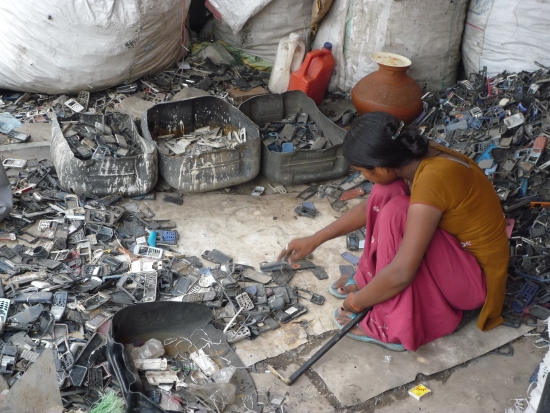| |
|
Plastics recycling in Delhi (India): Deconstruction, sorting and preparation of polymeric components involves a lot of manual work done mostly by women and children.
|
| |
| Non-renewable raw materials such as copper and gold originate in many cases in developing countries. The availability of many metals, for example rare earth elements, is becoming noticeably more critical. Therefore, efficient management of these raw materials is more important than ever. The recycling of discarded consumer goods can make a big contribution; much of this recycling involves electronic devices and household equipment. |
| |
e-waste as key economic factor
In developing countries, the recovery of raw materials is mainly carried out by thousands of uncontrolled workers in what is referred to as the “informal” sector. This involves numerous risks, such as environmental pollution, health hazards and the cross-contamination of hazardous substances. In general there is a lack of quality and sustainability standards. A study recently carried out in New Delhi showed that the recycling of plastics is an important economic activity, which in this city alone employs between 20,000 and 25,000 people in more than 7,000 small businesses. The analysis also showed that the lead content in recycled plastics, which can for example be used to produce children’s toys and crockery, is sometimes significantly above the prescribed European limit. Consequently, as part of the new collaboration between SECO and Empa, an international process is being launched to develop new quality and sustainability standards for secondary raw materials. |
| |
|
| |
|
|
|
Cows searching for leftovers amongst the poisonous waste on an informal waste tip in Accra (Ghana): In the background, there is a lagoon that has been highly contaminated by the informal recycling activities. |
| |
|
| |
The success story continues …
SECO and Empa have been cooperating successfully since 2003 in the area of e-waste. As part of the “Swiss e-Waste Program”, they have supported India, China, South Africa as well as Columbia and Peru in their efforts to improve their e-waste management systems. Meanwhile, appropriate regulations have been enacted in virtually every partner country. In Peru and Columbia, it has also been possible to agree on guidelines, based on the Swiss model, relating to advanced disposal fees. |
| |
| These results have led to the development of a comprehensive approach in the form the “Sustainable Recycling Industries” follow-up program. The target is to achieve the sustainable recovery of raw materials, so-called secondary raw materials, and to make them available for the international market. The new program focused on three main areas: |
| |
- Improvement of basic data for assessing the quality of secondary raw materials: In order to enable the assessment of the use of secondary raw materials in terms of their environmental and social soundness, it is necessary to assess their whole life-cycle – an eco-balance. However, there is often a lack of data about the various manufacturing activities in developing countries. Local or regional life cycle inventories could address this problem. This also meets the needs of consumers and companies in Switzerland who are increasingly demanding the sustainability of a product’s entire life cycle. Empa and the “ecoinvent” center are developing regional centers for the collection of data in India, South Africa, Egypt and Brazil.
- Support for pilot projects for improving recycling chains: The program is working together with private and public institutions in Ghana, South Africa, Egypt, Columbia, Peru and India. Pilot projects are being supported jointly so that best practices and recycling standards can be introduced via technological collaboration. With this approach, it is planned to achieve a market-oriented disposal of discarded consumer goods and the recycling of secondary raw materials as well as their subsequent reintroduction into global raw material markets.
- Introduction of sustainability criteria for non-renewable secondary raw materials: The topic of raw material recovery from consumer waste is currently being discussed by various bodies across the world. The new program will enrich these discussions with tangible results and practical experiences from the pilot projects and the regional centers for life cycle inventories. A multi-stakeholder platform will be formed in order to develop sustainability guidelines for non-renewable secondary raw materials.
|
| |
| |


